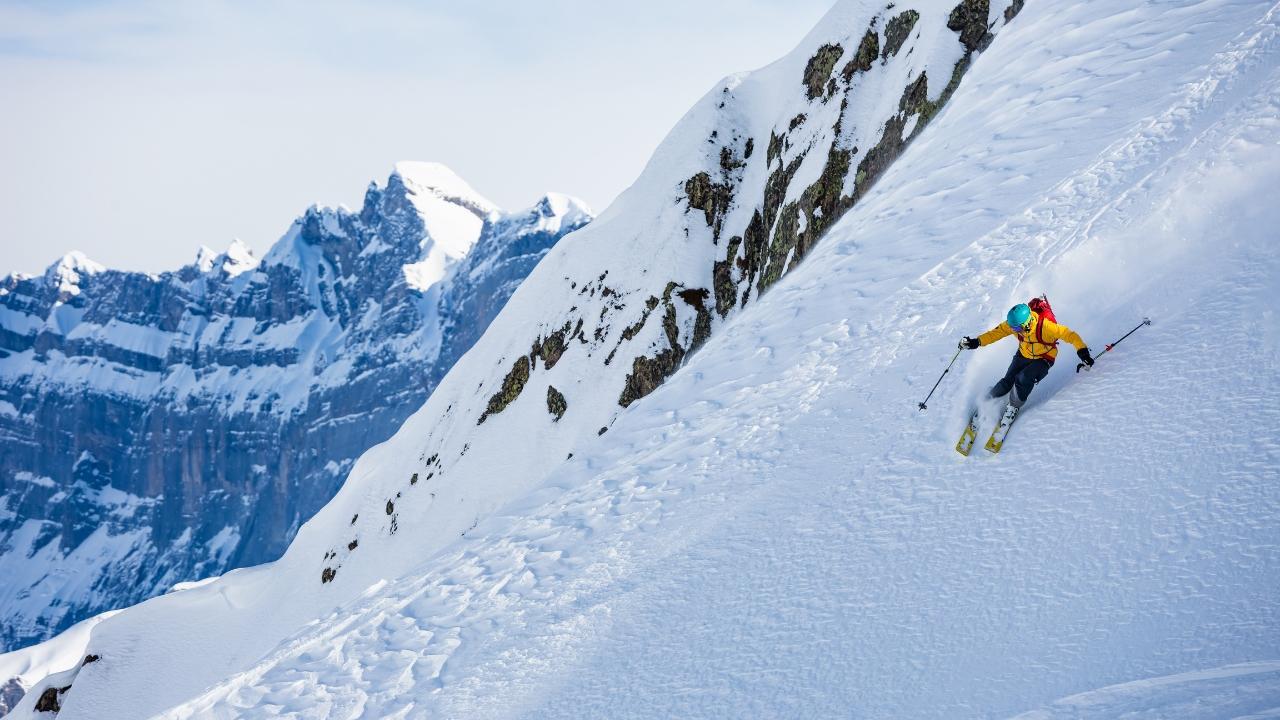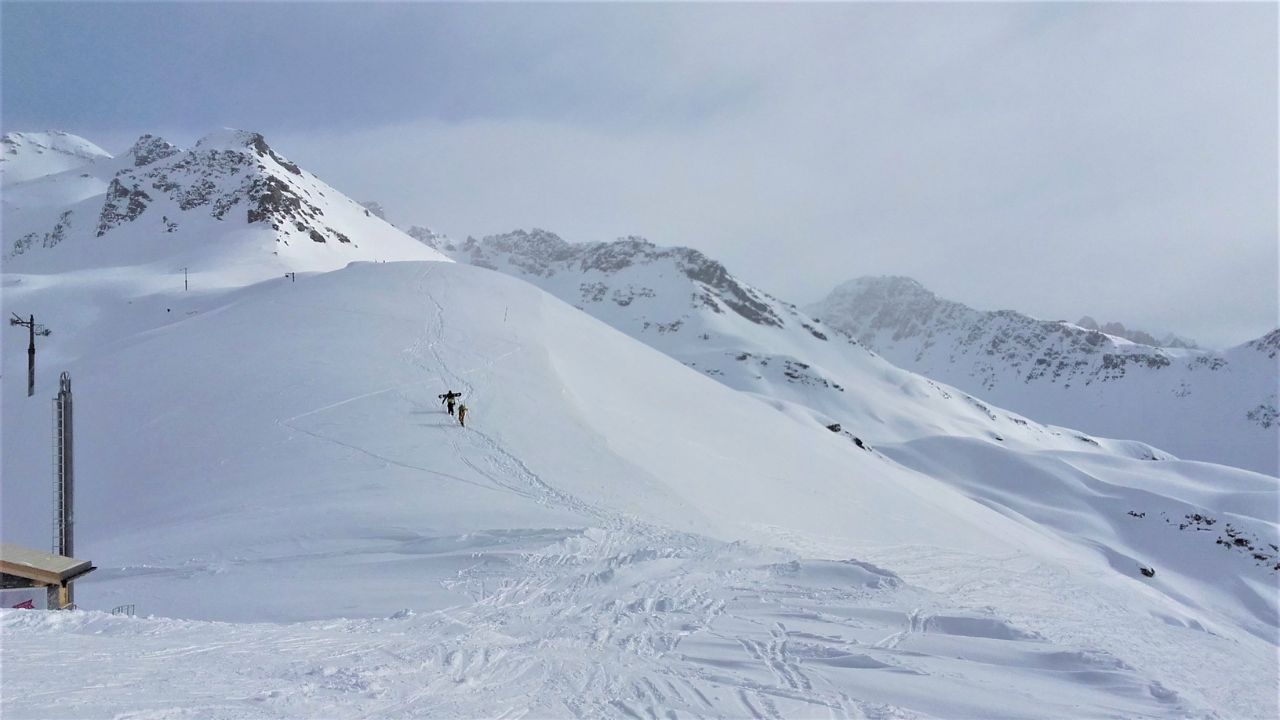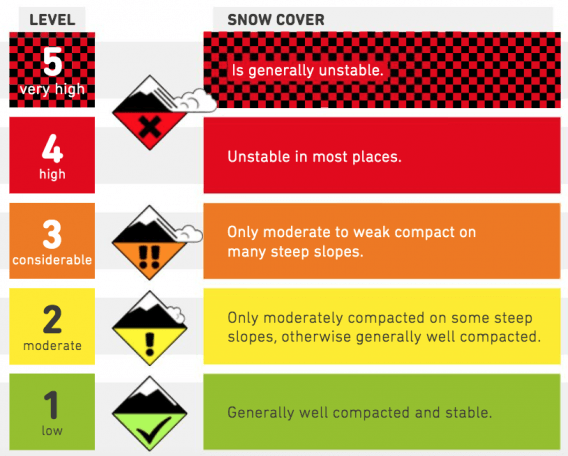How to ski powder?
Discover all our tips for powder skiing and learn the basic techniques of freeride skiing. Follow the guide!

Master the Powder: Your Ultimate Guide to Deep Snow Skiing
Ah, snow powder... That word alone is enough to make the eyes of any self-respecting skier shine, isn’t it? Sliding on a fresh layer of deep snow offers a feeling of freedom and euphoria that few experiences can match. But like any happiness worthy of the name, skiing in powder requires a bit of know-how and a pinch of technique.
You may be here because you have already experienced this exaltation and want to refine your art. Or maybe you dream of drawing your first curves in this pristine white carpet, but don’t know where to start. Whatever your reason, this guide is there to turn your descents into powder potential «oops» into unforgettable «wow».
Together, we will break down the mystery of powder snow into practical and proven technical tips. We’ll show you how to equip your feet and prepare your mind for this winter adventure, while making sure you keep a smile (and plenty of fresh air) from start to finish. Ready to leave your mark in the snow? Follow the guide!
Understand the fresh snow
What is snow powder?
Powder is much more than just snow; it is the epitome of winter for snow lovers. This freshly fallen, light and uncompressed snow is both a playground and a challenge for skiers. What’s special about it? A soft and airy texture that almost seems to caress the skis when you cross it. It is distinguished by its immaculate appearance, forming a virgin surface that invites to leave its mark.
Skiing in powder differs greatly from downhill groomed slopes. Here, the skis sink slightly, creating a resistance that requires a specific technique. It is this sensation of floating, sliding in a cloud that makes the experience so unique and sought after.
Why does powder fascinate skiers?
The fascination for powder in skiers is due to several factors, all more attractive than the others. First, there is this quest for perfection, purity. Drawing the first lines on a virgin expanse of snow powder gives a feeling of accomplishment, of communion with nature in what is more ephemeral and magical.
Then there is the technical aspect. Powder requires the skier to adapt his style, play with balance, gravity, and anticipate the terrain hidden under the snow. It is a dance, an art where every turn is a note and every descent a melody. For many, mastering this discipline represents the pinnacle of their skiing skill.
But beyond the technical aspect, there is pure emotion. To slip into the powder is to live a moment of absolute fullness, a moment when time seems suspended. The floating sensation, the enveloping silence of the mountain, the snow that flies around at every turn create an almost mystical experience.
Finally, powder skiing is also a symbol of freedom. Off the marked slopes, facing the immensity of the mountain, the skier becomes explorer, pioneer. It is the opportunity to compete with nature, to discover places inaccessible otherwise, to push its limits.
In short, powder fascinates because it encapsulates all that skiing has to offer: challenge, beauty, escape, and pure, raw and unaltered happiness. For skiing aficionados, it is this quest for the absolute, this promise of adventure that reminds them, year after year, on the snowy peaks. For your next powder adventure, discover a freeride area nestled at 2800 meters above sea level, Le Mont-Valaisan in La Rosière.
The equipment adapted to the powder
The right equipment plays a crucial role in the experience of powder skiing. Not only can it improve your performance and comfort, but it can also contribute to your safety. Here’s an overview of what to consider for your next deep snow adventure.
The choice of skis for powder
The powder skis are specifically designed to offer better lift on soft and deep snow. They are generally wider than conventional alpine skis, with a skate width often exceeding 100 mm. This additional width allows the skis to "float" on the snow rather than sink, thus facilitating the glide and reducing the physical effort required.
Ski models recommended for the powder
- Rossignol Black Ops: With their wide profile and lightweight construction, these skis offer excellent maneuverability in powder while remaining efficient on more varied terrain.
- Salomon QST 106: Balanced and versatile, these skis are designed for powder but adapt well to all conditions, offering good stability and precise control.
- Atomic Bent Chetler 120: Ultra-wide and with exceptional flotation, these skis are ideal for deep powder days, allowing easy turns and unparalleled gliding pleasure.
In addition to the width, pay attention to the shape of the ski, especially the rocker (curvature of the ski) which also contributes to the lift in powder. A pronounced rocker at the front of the ski helps lift the spatula out of the snow, while a rocker at the back facilitates turns and maneuverability. Book now your freeride ski rental in one of our stores!
Clothing and accessories to go in the powder
In addition to the skis, the clothing and accessories are essential for a successful day in the powder. The goal is to stay warm, dry, and protected, while maintaining optimal freedom of movement.
- Ski jackets and pants: Opt for waterproof and breathable clothing. Technologies like Gore-Tex offer excellent moisture protection while wicking away sweat. Brands such as Patagonia and Arc'teryx offer tailored jackets and pants, with waterproof seams and zipped vents to regulate body temperature.
- Avalanche protection: In powder skiing, especially off-piste, it is crucial to equip yourself with a DVA (Avalanche Victim Detector), a shovel and a probe. Brands like Black Diamond and Ortovox offer reliable equipment that can make a difference in an emergency.
- Accessories: Do not underestimate the importance of a good pair of gloves or mittens (recommended brands: Hestra or Black Diamond), protective glasses with good ventilation to avoid fogging (Oakley or Smith), and a cap or hood to protect your extremities from the cold.
- Backpack: A specific backpack for skiing can also be very useful for carrying your belongings, especially for long days. Choose a model with ski bindings and enough room for a first aid kit, water, and snacks. Osprey and CamelBak offer ergonomic options designed for skiing.
Basic techniques for skiing in powder
Mastering powder requires adapting to its unique environment. Here are some basic techniques to help you get the most out of deep snow.
Adopt the right posture
Good posture is essential for skiing effectively in powder. It differs slightly from that adopted on groomed or icy slopes, mainly due to the density and depth of the snow.
- Centered balance: Keep your weight centered on your skis. Unlike hard snow skiing where you can lean forward, in powder, a weight too far forward can cause your spatulas to plunge under the snow, which will make turns difficult and may cause you to fall.
- Knee Flexion: Keep your knees slightly bent. This will help you absorb changes in the terrain and stay agile. Good flexion also helps to distribute your weight over the entire length of the skis, thus improving flotation.
- Arms Forward: Hold your arms in front of you. This promotes balance and helps direct your movements. Your ski poles should be ready to plant in the snow at any time to help maneuver and maintain balance.
Manage speed and cornering
Powder requires a different approach to speed management and turns compared to hard snow.
- Speed control: Use snow texture to your advantage. Powder offers natural resistance that can help control your speed. Rather than braking abruptly, consider using wider turns and letting the snow act as a shock absorber.
- Initiate turns: In powder, turns should be more fluid and less aggressive. Instead of turning abruptly, lean gently to one side to initiate the turn. Imagine drawing a curved line in the snow rather than cutting through it.
- Using sticks: Sticks become especially useful in powder to maintain balance during turns. Firmly plant your stick in the snow at the beginning of the turn to give yourself a fulcrum around which to pivot.
Mastering these basic techniques will allow you to adapt to the unique challenges presented by powder. With practice, you will develop a feeling of flotation and freedom while skiing in the deep snow, turning each descent into a memorable experience. The key is to stay relaxed, keep a good balance, and let your skis and snow do the work for you.
Advanced techniques for skiing in powder
Skiing in powder can be a transcendent experience, but it requires a certain finesse and advanced understanding of techniques and terrain. Here’s how you can take your powder skiing to the next level.
Perfect your techniques in powder
For skiers looking to perfect their technique in powder, some adjustments and advanced practices can make all the difference.
- Dynamism and flotation: To really master the powder, learn to play with the dynamics of your body and the flotation of skis. This means constantly adjusting your center of gravity and using the flexibility of your skis to maintain flotation. As you enter a turn, gently press the downhill ski (the ski at the bottom of the slope) to dig into the snow and initiate the turn, then transfer your weight to the upstream ski (the ski at the top of the slope) to exit the turn and move on to the next.
- Jumps and transitions: Powder terrain often offers opportunities for natural jumps. Practice aerial transitions by keeping your skis parallel and landing with your knees bent to absorb the impact. Using the terrain to your advantage can add an entirely new dimension to your powder skiing.
- Skiing in the forest: Skiing in the forest or between trees is an advanced discipline that requires precision and responsiveness. The key is to keep your gaze fixed between the trees where you want to go, rather than on the obstacles to avoid. This helps to naturally guide your movements and maintain a constant flow.
Read the terrain and choose its lines
The ability to read the terrain and choose its lines wisely is crucial for powder skiing, especially in off-piste terrain.
- Terrain Analysis: Before you start, take a moment to observe the terrain. Identify areas where snow appears to be deepest and most likely to provide good flotation. Also be on the lookout for potential obstacles like rocks or tree stumps hidden under the snow.
- Choice of lines: A good line in powder is not only the most direct or the deepest; it is the one that offers the best experience depending on your level and style of skiing. Look for lines that offer a variety of terrain, such as gentle slopes to accelerate and more technical areas to test your agility.
- Anticipation and adaptation: When skiing, anticipate the terrain ahead and be ready to adapt. This can mean slowing down before a particularly steep section or preparing a turn to avoid an obstacle. Anticipation and the ability to adapt quickly are the marks of a skier expert in powder.
Mastering these advanced techniques requires practice, patience, and a certain courage to get out of your comfort zone. However, the rewards – the feeling of flying through the snow, tracing your own path through a pristine winter landscape – are unmatched. Remember, safety should always be your priority, especially when exploring unfamiliar or challenging terrain. With these advanced skills, you are ready to turn every powder run into a memorable adventure.
Safety and precautions in powder
Skiing in powder offers an unforgettable experience, but it comes with specific risks, especially outside the marked trails. Preparation and proper equipment are essential to minimize these risks and take full advantage of the mountain.
The essential safety equipment
Before venturing into the powder, especially off-piste, make sure you have the necessary safety equipment to deal with emergency situations, including avalanches.
- DVA (Avalanche Victim Detector): Also known as ARVA (Avalanche Victim Finder), DVA is essential to quickly locate a person buried by an avalanche. All group members must wear a DVA in broadcast mode and know how to use it in search mode.
- Shovel and probe: In case of avalanche, the shovel is used to clear the snow to extract the victims. The probe can precisely locate a person under the snow. These tools are useless without proper training in their use, so be sure to train yourself.
- Airbag Backpack: In the event of an avalanche, an airbag backpack can significantly increase your chances of staying on the snow surface. Although it represents an investment, its efficiency makes it an increasingly popular tool among off-piste skiers.
- First aid equipment: A compact first aid kit, containing essential items such as dressings, bandages, and survival blankets, can be vital in the event of an accident.
Tips for safe group skiing
Group skiing in powder can increase the pleasure of the experience, but it requires clear coordination and communication to ensure everyone’s safety.
- Never ski alone: Always ski in powder with at least one partner. In the event of an accident, you can count on the immediate help of your group.
- Clear communication: Before leaving, discuss the route, meeting points, and communication signals. Make sure everyone knows what to do in an emergency.
- Stay in sight: Always keep at least one member of the group in sight. This allows for quick intervention if someone encounters difficulties.
- Respect the tours: Leave enough space between each skier during the descent. This minimizes the risk of triggering an avalanche and gives everyone the time and space to react in the event of a problem.
- Know your limits: Honestly assess your skill level and that of your group. Do not engage in terrain that exceeds your abilities or those of your partners.
- Training and knowledge: Taking avalanche safety training is highly recommended for all skiers venturing off the slopes. Knowing the basics of snow science (snow study) and rescue techniques can make a crucial difference.
Safety in powder snow is not limited to equipment; it is based on rigorous preparation, in-depth knowledge of the terrain, and constant compliance with safety principles. By adopting these practices, you ensure not only your own safety but also that of your ski companions, allowing everyone to enjoy the joys of the powder in all serenity.
Take full advantage of the powder experience
Powder skiing is often considered the ultimate experience by ski enthusiasts. To make the most of these magical moments, some preparations and knowledge are essential.

Find the best powder spots
The quest for the perfect powder spots can feel like an adventure. Here’s how to increase your chances of success:
- Check the avalanche bulletins: Above all, safety. Local avalanche bulletins provide a wealth of information on snow conditions and associated risks.
- Dialogue with locals: Ski instructors, mountain guides, and passionate locals are often the best sources to discover non-obvious powder spots.
- Be early: Fresh powder attracts crowds. Being on the slopes early gives you a head start to enjoy the best conditions.
- Explore with a guide: For off-piste areas, hiring a guide can not only improve your safety but also lead you to exceptional spots that you might not have found alone.

Improve your endurance and technique
Powder requires more physical effort than groomed skiing. Here’s how to prepare:
- Physical training: Strengthen your cardiovascular endurance, leg strength and balance. Cycling, running, and yoga are excellent complementary activities to skiing.
- Technical ski sessions: Use every skiing opportunity to work on your technique. Consider specialized powder courses to refine your skills.
- Rest and recovery: Endurance is not just about effort; it’s also about knowing when to rest. Make sure to recover well between your ski days.
Mastering the powder: Keys to an unforgettable winter adventure
Are you ready to conquer the powder with ease and safety? Freeride is here to accompany you in this adventure. Visit our website or visit one of our stores to equip your passion with the best equipment available. Don’t let the fresh snow wait for you, book your Freeride ski hire and make every descent an epic adventure. And find our guide on the best freeride ski spots in France!